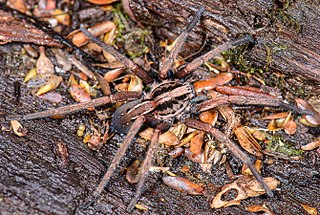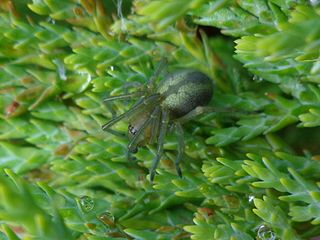
The sac spiders of the family Clubionidae are nocturnal, sac-building hunting spiders with a near-worldwide distribution. Their sacs, silken retreats in which they hide during the day, may be made in a variety of places, including between folded leaves or grass blades, under bark and below rocks or other ground litter.

Miturgidae is a family of araneomorph spiders that includes nearly 170 species in 29 genera worldwide. First described by Eugène Simon in 1886, it has been substantially revised, and includes the previous family Zoridae as a synonym, and excludes the family Xenoctenidae. Several genera have also been removed, such as the large genus Cheiracanthium, which was transferred to the Cheiracanthiidae.

Liocranidae is a family of araneomorph spiders first described by Eugène Simon in 1897. They are one of several groups called "sac spiders". The holarctic genus Agroeca is the best-known, but it also includes various genera of more obscure spiders that still lack a diagnosis. Two species in the North American genus Neoanagraphis are found in the extremely dry conditions in the Mojave, Sonoran and Chihuahuan deserts. Females live in animal burrows while males wander and are the ones most often caught in pitfall traps.

Eugène Louis Simon was a French naturalist who worked particularly on insects and spiders, but also on birds and plants. He is by far the most prolific spider taxonomist in history, describing over 4,000 species.

Dwarf sheet spiders (Hahniidae) is a family of araneomorph spiders, first described by Philipp Bertkau in 1878.
Rhyphelia is a genus of South American jumping spiders. It was first described by Eugène Louis Simon in 1902, and is found only in northern South America.

Nicodamidae is a family of araneomorph spiders with twenty-seven species in seven genera. They are small to medium-sized spiders found near the ground of eucalypt forest in small sheet webs. The species of this family are only present in Australia and Papua New Guinea. In most cases the cephalothorax and legs are uniformly red and the abdomen black, for which these species are sometimes called the "red and black spiders".

Cycloctenidae is a family of spiders first described by Eugène Simon in 1898.

Cheiracanthium, commonly called yellow sac spiders, is a genus of araneomorph spiders in the family Cheiracanthiidae, and was first described by Carl Ludwig Koch in 1839. They are usually pale in colour, and have an abdomen that can range from yellow to beige. Both sexes range in size from 5 to 10 millimetres. They are unique among common house spiders because their tarsi do not point either outward, like members of Tegenaria, or inward, like members of Araneus, making them easier to identify.

Pisaura is a genus of Eurasian spiders in the family Pisauridae.
Cheiracanthium fulvotestaceum is a spider species found in France. It was first described by Eugène Simon in 1878.

Cheiracanthiidae is a family of araneomorph spiders first described by Vladimir Wagner in 1887. The synonym Eutichuridae was used for a long time, but Cheiracanthiidae has priority. The largest genus currently recognized as belonging to this family is Cheiracanthium, which has previously been placed in both the Clubionidae and the Miturgidae.

Scotophaeus is a genus of ground spiders that was first described by Eugène Simon in 1893.

Aphantaulax is a genus of ground spiders that was first described by Eugène Simon in 1878.

Cheiracanthium erraticum, the two-clawed hunting spider, is a species of Palearctic spider of the family Cheiracanthiidae.
Agraecina is a genus of liocranid sac spiders that was first described by Eugène Louis Simon in 1932. Most species in the genus have a restricted habitat and narrow distribution, with exception of type species Agraecina lineata, which is known from a wider range of habitats over a larger area.
Leptodrassus is a genus of ground spiders that was first described by Eugène Simon in 1878.

Floronia is a genus of spiders in the family Linyphiidae first described by Eugène Simon in 1887.

Eutittha is a genus of spiders in the family Cheiracanthiidae. It was first described by Tamerlan Thorell in 1878.














